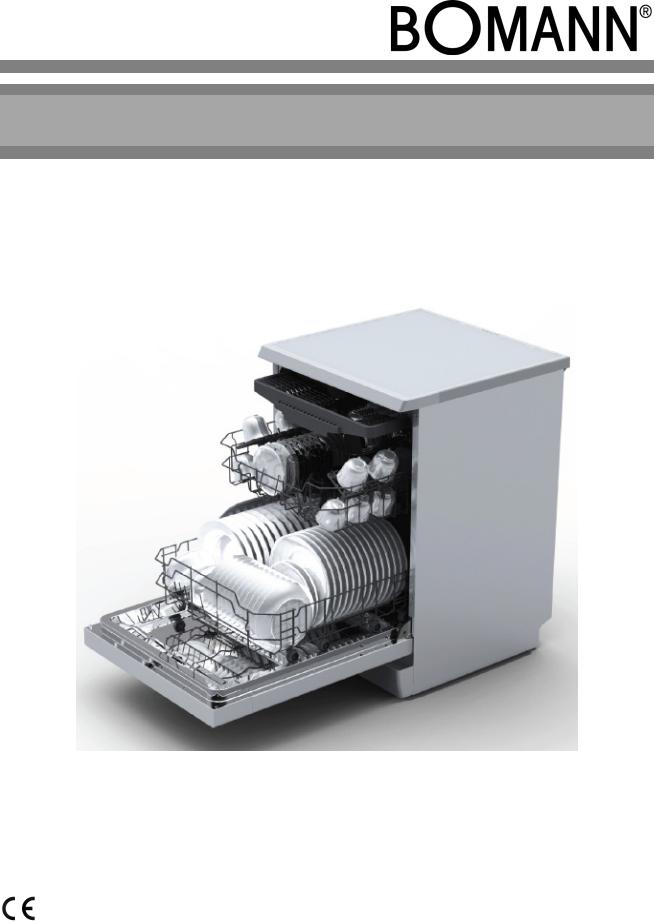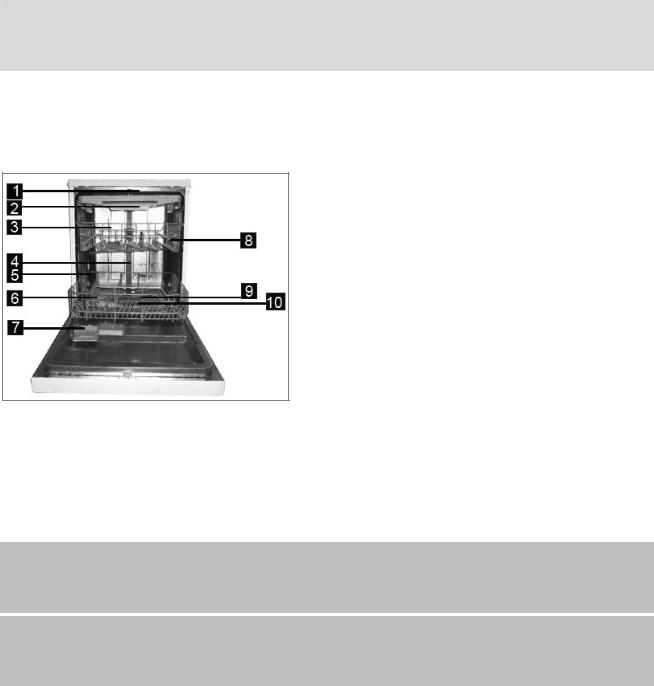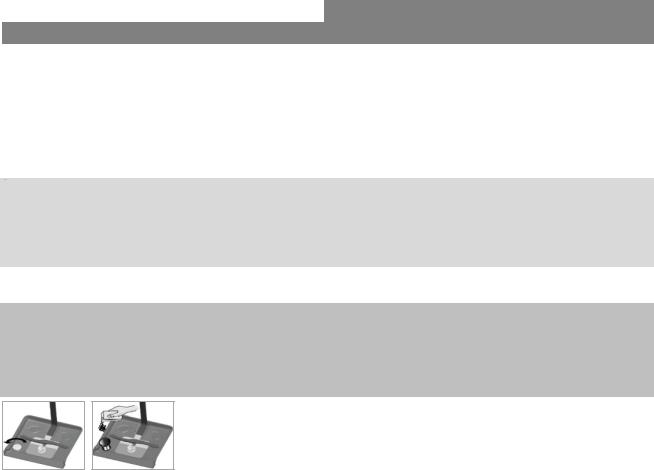Bomann GSP 849 operation manual

HOUSEHOLD- DISHWASHER GSP 849
Instruction Manual
|
Contents |
Introduction |
.................................................................................................................................................Page 3 |
General Notes…………………………………………………………………...………….…………….….…….Page 3 Special safety Information for this Unit……………………………………………..………………..…………..Page 4 Unpacking the Appliance………………...………………….………………………………………....…..…..…Page 5 Appliance Equipment...………………..….……………………………………………….………….….………..Page 5 Installation…………………………………………………………………………………………………..………Page 5 Prior Using for the first Time.…………………………………..……………………………….…....….……..…Page 7 Loading the Dishwasher Baskets…………..………………..………………………………….…..……...…..Page 10 Starting a Rinse Program………………………………..…………........…………….…………..……………Page 12 Cleaning and Maintenance…………………………........…………………………………....……..……..…..Page 15 Troubleshooting……………………..………………………………………………….……………...…......….Page 17 Technical Data……………...……………………………..……..……………………….………………………Page 19 Disposal….………………………..……….………………………………………….………………..……..…..Page 20
2

Introduction
Thank you for choosing our product. We hope you will enjoy using the appliance.
Symbols in these Instructions for Use
Important information for your safety is specially marked. It is essential to comply with these instructions in order to avoid accidents and prevent damage to the machine:
 WARNING:
WARNING:
This warns you of dangers to your health and indicates possible injury risks.
 CAUTION:
CAUTION:
This refers to possible hazards to the machine or other objects.
 NOTE: This highlights tips and information.
NOTE: This highlights tips and information.
General Notes
Read the operating instructions carefully before putting the appliance into operation and keep the instructions including the warranty and the receipt. If you give this device to other people, please also pass on the operating instructions.
 NOTE: The illustrations in this instruction manual can deviate from the original appliance.
NOTE: The illustrations in this instruction manual can deviate from the original appliance.
•The appliance is designed exclusively for private use and for the envisaged purpose. This appliance is not fit for commercial use.
•The appliance is only to be used as described in the user manual. Do not use the appliance for any other purpose. Any other use is not intended and can result in damages or personal injuries.
•Do not use it outdoors. Keep it away from sources of heat, direct sunlight and humidity.
•Do not operate the appliance without supervision.
•When not in use, for cleaning, user maintenance works or with disruption, switch off the appliance and disconnect the plug (pull the plug itself, not the lead) or turn off the fuse.
•The appliance and if possible the mains lead have to be checked regularly for signs of damage. If damage is found the appliance must not be used.
•For safety reasons, alterations or modifications of the appliance are prohibited.
•In order to ensure your children’s safety, please keep all packaging (plastic bags, boxes, polystyrene etc.) out of their reach.
 WARNING:
WARNING:
Do not allow small children to play with the foil. There is a danger of suffocation!
3
Special safety Information for this Unit
•The maximum number of place settings to be washed is 10.
•This unit is intended to be used in household and similar applications such as
-staff kitchen areas in shops, offices and other working environments;
-by clients in hotels, motels and other residential type environments;
-in farm houses.
•The appliance is to be connected to the water mains using new hose sets and that old hose-sets should not be reused.
•The maximum permissible inlet water pressure is 1 Mpa.
•The minimum permissible inlet water pressure is 0.04 Mpa.
•In the appliance bottom are located ventilation openings (depending on model). These may not be clogged e.g. by carpet.
•Open the door carefully during operation, there is a risk of water squirting out.
•Pay attention to a proper loading of the appliance. Follow the instructions in the chapter “Loading the Dishwasher Baskets”.
•Knives and other utensils with sharp points must be loaded with their points down in the cutlery basket (depending on model) or placed in a horizontal position in the dishwasher basket.
•The door should not be left open, since this could increase the risk of tripping.
•This appliance can be used by children aged from 8 years and above and persons with reduced physical, sensory or mental capabilities or lack of experience and knowledge if they have been given supervision or instruction concerning use of the appliance in a safe way and understand the hazards involved.
•Children who are younger than 8 years must be kept away from the device.
•Children shall not play with the appliance.
•Cleaning and user maintenance shall not be made by children, unless they are older than 8 years and are supervised.
•Do not try to repair the appliance on your own. Always contact an authorized technician. If the supply cord is damaged, it must be replaced by the manufacturer, its service agent or similarly qualified persons in order to avoid a hazard.
4

Unpacking the Appliance
•Remove the appliance from its packaging.
•Remove all packaging material, such as foils, filler and cardboard packaging.
•To prevent hazards, check the appliance for any transport damage.
•In case of damage, do not put the appliance into operation. Contact your distributor.
 NOTE:
NOTE:
Production residue or dust may have collected on the appliance. We recommend cleaning the appliance according to chapter “Cleaning and Maintenance”.
Appliance Equipment
Appliance overview
1 |
Upper spray arm |
2 |
Cutlery rack |
3 |
Upper basket |
4 |
Inner water pipe |
5 |
Lower basket |
6 |
Salt container (water softener) |
7 |
Detergent / Rinse aid dispenser |
8 |
Cup shelf |
9 |
Lower spray arm |
10 |
Filter system |
|
|
Delivery scope
cub shelf (2 pcs), funnel tube, inlet hose safety system
Installation
 WARNING:
WARNING:
The unit must not be connected to the mains during installing. Otherwise there is danger to life or electric shock hazard!
 CAUTION:
CAUTION:
For a correct operation the appliance must be connected properly. The specifications for water supply and drain as well as the electrical connection must fulfill the required criteria.
Installation location
•The site should be located near the water inlet and outlet, as well as near a properly grounded power socket.
5

•Take care of a solid and horizontal position of the appliance. If the appliance is not horizontally leveled, adjust the feet accordingly.
•Power cable and water hoses may not kinked or squashed.
•Avoid the installation:
-near heaters, next to a stove, direct sunlight or any other heat sources;
-at locations with high humidity (e.g. outdoors), as metal parts would be susceptible to corrosion under such circumstances;
-in rooms where the temperature could drop below freezing. Do not expose the appliance any weather.
-near volatile or flammable materials (e.g. gas, fuel, alcohol, paint, etc.).
Water connection
 CAUTION:
CAUTION:
•The Installation of the water supply must conform to the local laws and regulations.
•Use the new supplied hose set to connect the appliance to the water supply. Do not reuse old or used connection sets.
•If the water pipe is new or long time not used, ensure before connecting to the water system, that the water is clear and free from contamination.
Notes on inlet hose safety system (included in delivery)
The safety system consists of a double-walled inlet hose. This system guarantees to cut off the water supply when leakage of the inner hose. Switching off the water supply leads over an electronic contact.
Connect the water inlet hose (cold water connection)  NOTE:
NOTE:
The water pressure must be between 0.04 and 1 MPa. With higher pressure: use a pressure regulator.
•Connect the water inlet hose to a water thread with ¾“. Screw the hose firmly in the direction of the screw thread; pay attention for a tight fit.
•Connect the other end of the inlet hose to the inlet valve on the appliance back; pay attention for a tight fit too.
Hot water supply
The dishwasher can be supplied with a water temperature of not more than 60°C. Supplying the appliance with hot water, the rinse running time is shortened but the cleaning effect can be slightly reduced. The connection to the hot water valve must be done in the same manner as described for the cold water connection.
Connect the water drain hose  NOTE:
NOTE:
The drain hose has a length of approx. 1.5 m and can extend with a suitable hose and connecting piece to a length of max. 4 m.
6

 CAUTION:
CAUTION:
In order to prevent backflow of contaminated water, the free end of the hose must not come under the water level of the drain.
•Connect the drain hose to a drain pipe with a minimum diameter of Ø 40 mm; alternatively the drain hose can be fixed directly to the sink.
•Always make sure that the hose is not bent or squeezed.
•It is allowed to install the hose maximal up to a height of 1000 mm above the rinsing floor.
•Secure the drain hose securely to avoid a change in position and with it a water leakage.
Electrical connection
 WARNING:
WARNING:
•The installation to the mains supply must conform to the local standards and regulations.
•Improper connection may cause to an electric shock!
•Do not use multiple sockets or extension cords.
•It is not allowed to modify the plug provided with the appliance. If the plug does not fit properly to the outlet, let install a proper outlet by an authorized specialist.
•The accessibility of the power plug must always be ensured in order to disconnect the device from the power supply in case of an emergency.
•Ensure that your mains power corresponds with the specifications of the appliance. The specifications are printed on the rating label.
•Connect the mains cable to a properly installed and earthed wall outlet.
•If the plug after installation is not accessible, a corresponding disconnect device must be available to meet the relevant safety regulations.
Prior Using for the first Time
Before using your dishwasher for the first time:
A.Filling salt into the salt container (water softener)
B.Fill the rinse aid dispenser
C.Fill in detergent
 CAUTION:
CAUTION:
•Use only salt, rinse aid and detergent for dishwashers. Other products may damage the appliance.
•Always consider the dosage and storage recommendations on the sales packaging.
 WARNING:
WARNING:
Keep salt, rinse aid and detergent out of reach for children.
7

A. Filling salt into the salt container (water softener)
Water softener
The water hardness varies regionally. If hard water is used in the dishwasher, deposits form on the dishes and kitchen utensils. The appliance is equipped with a water softener, that removes lime and minerals from the water by using water softening in the salt container. Your local water authority can advise you on the hardness of the water in your area.
Adjusting the salt consumption
The salt consumption can be adjusted according to your water hardness and therefore optimally regulated.
•Open the appliance door and switch on the appliance using the Power button.
•Press the program selection button within the first 60 seconds for about 5 seconds. The warning lamps [rinse aid] and [salt] lights up when the appliance is in setting mode.
•By repeatedly pressing the program selection button, the water hardness can be changed accordingly. The display shows the setting: H1> H2> H3> H4> H5> H6.
•A few seconds after the completion of your choice the indication goes off and the water hardness is automatically saved. Finish the setup via the Power button.
The following settings are recommended:
|
|
|
Water hardness |
|
|
Display indication |
Salt consumption |
|||
°dH |
°fH |
°Clark |
mmol/l |
(gramm/cycle) |
||||||
|
||||||||||
0 |
- 5 |
0 |
- 9 |
0 |
- 6 |
0 - |
0.94 |
H1 |
0 |
|
|
|
|
|
|
|
|
||||
6 - 11 |
10 |
- 20 |
7 - 14 |
1.0 - 2.0 |
H2 |
9 |
||||
12 |
- 17 |
21 |
- 30 |
15 |
- 21 |
2.1 |
– 3.0 |
H3 (factory setting) |
12 |
|
|
|
|
|
|
|
|
|
|
|
|
18 |
- 22 |
31 |
- 40 |
22 |
- 28 |
3.1 |
– 4.0 |
H4 |
20 |
|
23 |
- 34 |
41 |
- 60 |
29 |
- 42 |
4.1 |
– 6.0 |
H5 |
30 |
|
|
|
|
|
|
|
|
|
|
|
|
35 |
- 55 |
61 |
- 98 |
43 |
- 69 |
6.1 |
– 9.8 |
H6 |
60 |
|
|
|
|
|
|
|
|
|
|
|
|
 NOTE:
NOTE:
°dH: German degree 1.25 mmol/l °fH: Frechn degree 0.178 mmol/l °Clark: British degree 1.78 mmol/l
Fill in the salt
 CAUTION:
CAUTION:
•The salt container must only be refilled when the salt warning lamp in the control panel lights up.
•During filling the salt container, salt and water can escape. Start a program immediately after you have filled the container to prevent corrosion.
•Remove the lower basket and unscrew the lid of the salt container.
•Add about 1.5 kg of salt by using the supplied funnel tube.
•Full fill the salt container with water (just before the first use).
•Screw the lid firmly on again after filling the container.
•Depending on salt dissolution, the salt warning lamp usually goes off immediately after filling the container.
8
